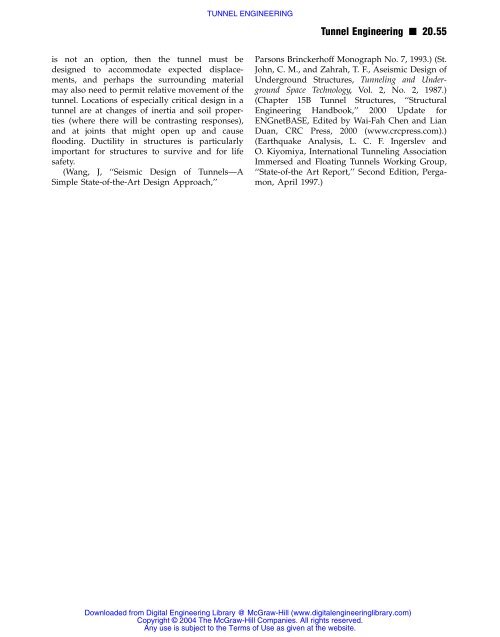TUNNEL ENGINEERING
TUNNEL ENGINEERING
TUNNEL ENGINEERING
You also want an ePaper? Increase the reach of your titles
YUMPU automatically turns print PDFs into web optimized ePapers that Google loves.
is not an option, then the tunnel must be<br />
designed to accommodate expected displacements,<br />
and perhaps the surrounding material<br />
may also need to permit relative movement of the<br />
tunnel. Locations of especially critical design in a<br />
tunnel are at changes of inertia and soil properties<br />
(where there will be contrasting responses),<br />
and at joints that might open up and cause<br />
flooding. Ductility in structures is particularly<br />
important for structures to survive and for life<br />
safety.<br />
(Wang, J, ‘‘Seismic Design of Tunnels—A<br />
Simple State-of-the-Art Design Approach,’’<br />
<strong>TUNNEL</strong> <strong>ENGINEERING</strong><br />
Tunnel Engineering n 20.55<br />
Parsons Brinckerhoff Monograph No. 7, 1993.) (St.<br />
John, C. M., and Zahrah, T. F., Aseismic Design of<br />
Underground Structures, Tunneling and Underground<br />
Space Technology, Vol. 2, No. 2, 1987.)<br />
(Chapter 15B Tunnel Structures, ‘‘Structural<br />
Engineering Handbook,’’ 2000 Update for<br />
ENGnetBASE, Edited by Wai-Fah Chen and Lian<br />
Duan, CRC Press, 2000 (www.crcpress.com).)<br />
(Earthquake Analysis, L. C. F. Ingerslev and<br />
O. Kiyomiya, International Tunneling Association<br />
Immersed and Floating Tunnels Working Group,<br />
‘‘State-of-the Art Report,’’ Second Edition, Pergamon,<br />
April 1997.)<br />
Downloaded from Digital Engineering Library @ McGraw-Hill (www.digitalengineeringlibrary.com)<br />
Copyright © 2004 The McGraw-Hill Companies. All rights reserved.<br />
Any use is subject to the Terms of Use as given at the website.
















